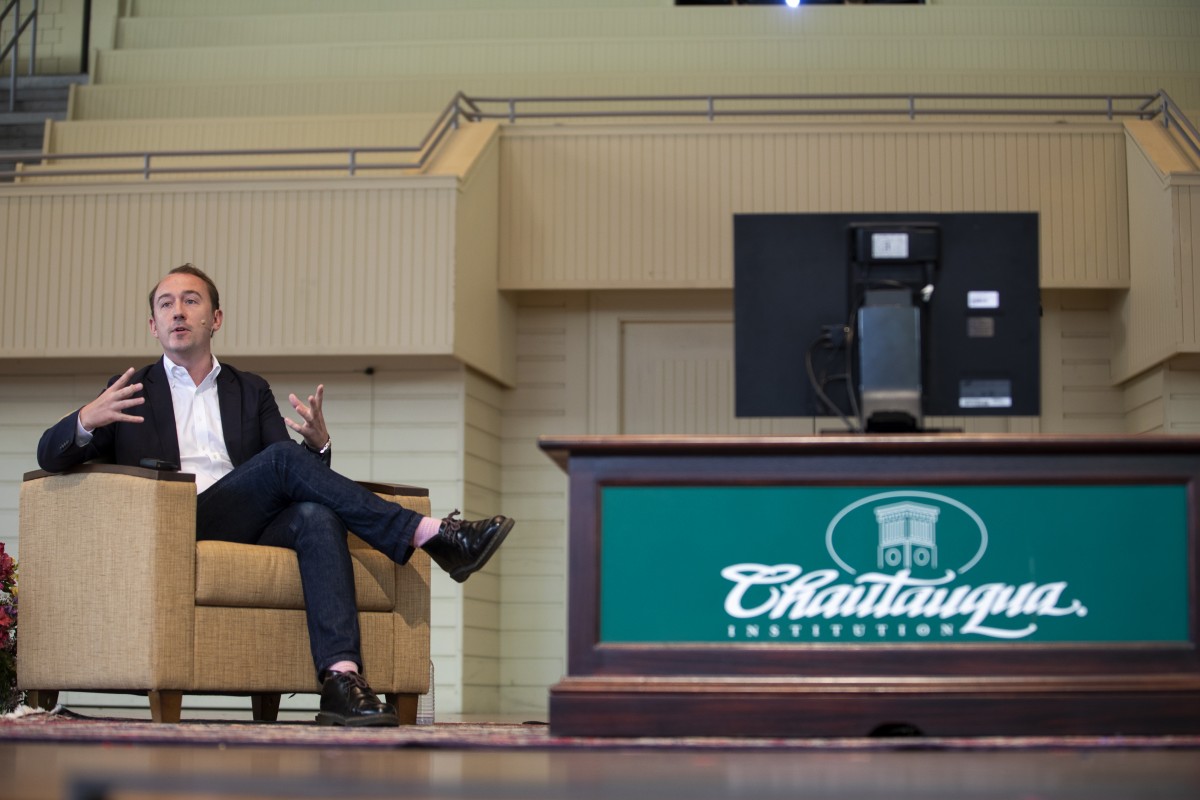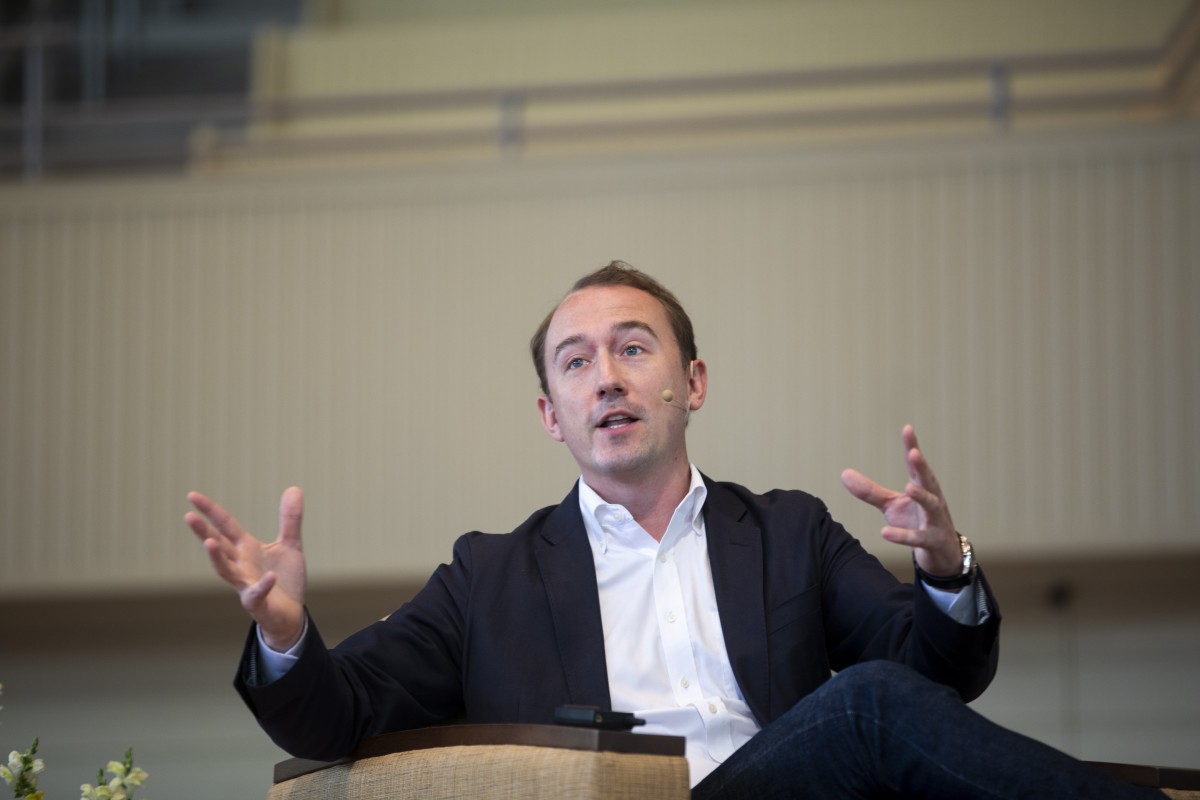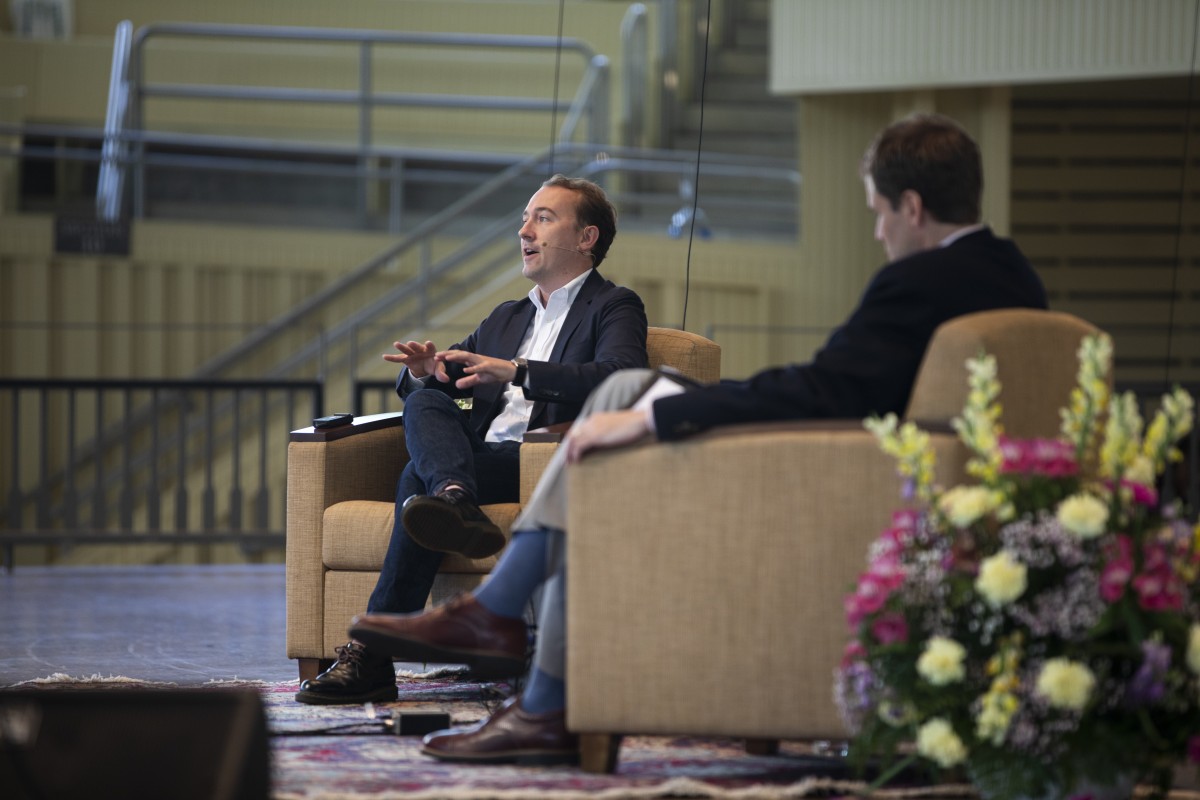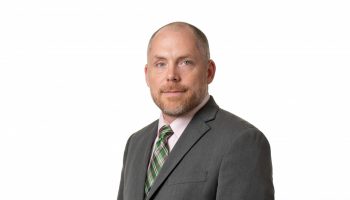Andrew Russeth spoke to the “art” in Week Seven’s theme, “The Arts and Global Understanding,” in a conversation with Chautauqua Institution Chief of Staff Matt Ewalt at Thursday’s, August 9, 10:45 a.m. morning lecture in the Amphitheater.
Former editor and founder of The New York Observer’s GalleristNY, the New York City-based art critic currently serves as co-executive editor of ARTnews. His writing has appeared in W, New York, Bijutsu Techo and Parkett, as well as on his contemporary art blog, “16 Miles of String.”
His lecture, titled “Crossing Over, Reaching Out: Collaborating Across Borders in Contemporary Art,” touched on artists, exhibitions and mediums that are participating in cross-cultural collaboration.
“If you look at the history of visual art, I think especially the history of art in the 20th century, pretty much every big change, every exciting development comes from some sort of cross-cultural guideline,” Russeth said. “… Then I think about cross-cultural collaboration, cross-cultural influence, … especially right now in contemporary art, where people are really trying to move beyond boundaries.”
Twentieth-century artist Robert Rauschenberg experimented with cross-cultural collaboration during his 1980s series, “Rauschenberg Overseas Culture Interchange.” Russeth read a quote from Rauschenberg, which he said summed up cross-cultural collaboration:
“I feel strong in my beliefs, based on my varied and widely travelled collaborations, that a one-to-one contact through art contains potent peaceful powers and is the nonelitist way to share exotic and common information, seducing us into creative mutual understandings for the benefit of all.”
Rauschenberg traveled across the globe from 1984 and 1991, learning new crafts from local artisans.
His work culminated in a collection of collages featuring native prints, newspapers, photographs from the places he visited and, occasionally, trash he collected from those visits.
Similarly, photographer Gauri Gill of New Delhi documents rural India, including makeshift graves of various religious sects and west-central Indian artisan masks, while also collaborating with other Indian visual artists. Russeth quoted her:
“I think these are powerful voices and I feel like part of my job as a photographer is just to listen — it’s a kind of active listening.”
Aside from individual artists, exhibitions are also venturing into cross-cultural collaborations and exploration, Russeth said.
“The art world is in an interesting moment,” he said. “Predominantly, it’s been in Europe and North America, a very Eurocentric, very white place. But we’re seeing recently, because of activism, because of pressure, because of some policy changes in government, a real effort to embrace difference, to be more diverse.”
Russeth offered two established, large exhibitions as examples: “Prospect” in New Orleans and “documenta.”
“Prospect” grew out of the devastation caused by Hurricane Katrina as a way for art to heal, Russeth said. Artist Mark Bradford collected discarded wood from the wreckage of Katrina and created an ark, similar to the Biblical tale of Noah; Kiluanji Kia Henda photographed performers on pedestals where statutes of colonizers once stood; and Barkley L. Hendricks’ portraits of African-American subjects replaced European artists of the colonial period in the New Orleans Museum of Art.
“Art exhibitions are also thinking about ‘We need to get away from art as paintings, art as sculpture, art made by people who went to a master of fine arts program’ — it’s everything in the world,” Russeth said. “It’s anything culture created.”
The exhibition series “documenta” began in 1955 to bring multicultural art to Germany after the erection of the Berlin Wall. Since its conception, “documenta” has been displayed 14 times. Its 14th edition featured “The Parthenon of Books” by Argentinian artist Marta Minujín. The piece is a replica of the Athenian Parthenon made of 100,000 banned books at the site of the 1930s book burnings in Kassel.
Other featured works included that of Cecilia Vicuña, who utilizes traditional Chilean knot making; Rick Lowe, who refurbishes houses for community use; and Ibrahim Mahama, who covers public structures with jute-sack quilts from local venders.
“(Mahama) weaves them together in these giant tapestries, using oftentimes art students, oftentimes local people, and then drapes them in plazas or buildings,” Russeth said. “So it becomes this interweaving of cultures — the merchants who decided they were going to part with their work and people who stitched them together, and his work.”
Russeth also provided a smaller, lesser-known exhibition as an example: “The Racial Imaginary Institute: On Whiteness,” which featured Anicka Yi’s crossover of art and science where she combined the scent of an Asian women with the scent of an ant as a critical remark on the stereotypes of Asian people.
To close, Russeth offered three examples of cross-cultural collaboration pushing into politics and real-world issues.
The first was a piece by Christoph Büchel called “The Mosque” — a repurposed decrepit church, which served as a mosque in the historic district of Venice, Italy, where there are no other mosques. The installation was eventually shut down by police, which many in the art community saw as religious censorship, Russeth said.
Russeth then discussed Sam Durant’s “Scaffold,” a sculptural, large-scale gallows in Minnesota created to highlight the mass execution of the Dakota people ordered by President Abraham Lincoln. The Dakota people protested, arguing Durant, a white man, was not equipped to tell their story; Durant apologized and gave the Dakota people the rights to the structure, which they buried.
“Consequently since then, there have been initiatives to collect more art by Native Americans, to have community leaders involved in decision-making about curating,” Russeth said. “But it is very much a work in progress. A lot of museums now are trying to take steps to really engage a diverse variety of communities.”
Finally, Olu Oguibe’s “Monument for Strangers and Refugees” is an obelisk engraved with the book of Matthew in four languages (German, English, Arabic and Turkish) which became a source of debate in Kassel, Germany — some thought it was ugly and distasteful, others thought it was welcoming, Russeth said. Eventually, public opinion favored Oguibe, and the monument stayed in Kassel’s town square.
Russeth remarked how the piece’s simplicity — a few Bible verses plastered on a plain shape — sparked engagement about topical issues and revealed deep-rooted xenophobia in Kassel.
“See as much art as possible,” he said. “When something feels uncomfortable or you don’t like it, really then spend time with it. … When you are around great art and you give it time to work on you and you listen to it, you can understand someone’s background, someone’s viewpoint in a way that few other (media) provide. Just really listen, and when you get offended, dig in.”
After the conclusion of Russeth’s lecture, Jordan Steves, director of strategic communications and community relations, opened the Q-and-A by asking how the aforementioned artists draw attention to their work.
Russeth attributed the ever-diversifying art community to the onset of social media and the ease of sharing information.
Steves turned to the audience for questions; one attendee asked about cultural appropriation in art.
“There just aren’t easy answers oftentimes,” Russeth said. “I think the best we can hope is that these conversations about cultural appropriation lead to more thoughtful art-making, lead to more thoughtful shows.”
Other attendees asked about folk art’s role in cross-cultural collaboration, and for Russeth’s thoughts on the National Memorial for Peace and Justice, and the demolition of activist Ai Weiwei’s studio by Chinese authorities. Steves then asked why visual arts are an effective means of dissent.
“Humans are visual people,” Russeth said. “… It shows how powerful symbols are.”












